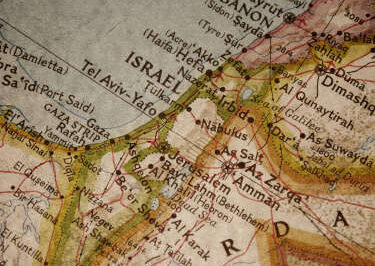Divided and Destroyed
Around 1025 B.C. Saul became the first king of Israel, and at last all the tribes were joined under one leader. He was followed to the throne by David, who established Jerusalem as the capital. Under the house of David, borders were defined and Israel became a prosperous and dominant nation. David’s son Solomon rose to power and honored God by building the first great temple in Jerusalem.
But by 926 B.C. Israel became a fractured kingdom when the ten tribes of the north (Israel) refused to take orders from Solomon’s son Rehoboam and revolted. The south, including the city of Jerusalem, was now a nation of its own—Judah. About 200 years later, the Assyrians conquered the northern kingdom of Israel—and it was only a matter of time before Judah and Jerusalem were to meet a tragic fate.
The Years of Exile
The Babylonians invaded Judah for the first time in 606 B.C. This is when King Nebuchadnezzar took captive some of the most educated and esteemed young men to Babylon to be trained for service in the king’s palace. Included in the captives were Daniel (renamed Belteshazzar), Hananiah (renamed Shadrach), Mishael (renamed Meshach), and Azariah (renamed Abednego) (see Daniel 1:1-7).
A few years later, Nebuchadnezzar sent his armies to Jerusalem once again and attacked the city (2 Kings 24:10). This time they looted the treasures of Solomon’s temple and carried them away. Nothing was left untouched. There was wholesale slaughter; every building was torched to the ground and the walls of Jerusalem were torn down. Thousands of survivors were taken into Babylonian captivity.
The Book of Lamentations details the horrors that took place during this time of devastation. In fact, in my conversations with Orthodox Jews, I learned that many of the tears that flow at the Western Wall in Jerusalem today are in memory of what occurred during this siege.
Exactly Seventy Years
One of the remarkable prophecies of the Old Testament concerns this exile of the Jewish people. God spoke through Jeremiah many years before the time of exile, promising, “After seventy years are completed at Babylon, I will visit you and perform My good word toward you, and cause you to return to this place” (Jeremiah 29:10).
How did this fulfillment of prophecy occur? Cyrus the Great of Persia (now Iran) conquered Babylonia (now Iraq), and one of his first decrees was to authorize the return of the Jewish people from Babylonian captivity to the land of Israel—in exchange for giving their loyalty to Persia. He also issued the order to rebuild the temple in Jerusalem, (see Ezra 1:1-2).
This was the God who said of Cyrus, “He is My shepherd, and he shall perform all My pleasure, saying to Jerusalem, ‘You shall be built,’ and to the temple, ‘Your foundation shall be laid'” (Isaiah 44:28).
Coincidence? I think not! The first stones for the second temple in Jerusalem were laid in 536 B.C.-exactly 70 years after Judah was captured. And the temple was built during the preaching ministry of Haggai and Zechariah (Ezra 5:1-2; Haggai 1:1-15). God said, “The glory of this latter temple shall be greater than the former” (Haggai 2:9).








Leave a Comment
You must be logged in to post a comment.